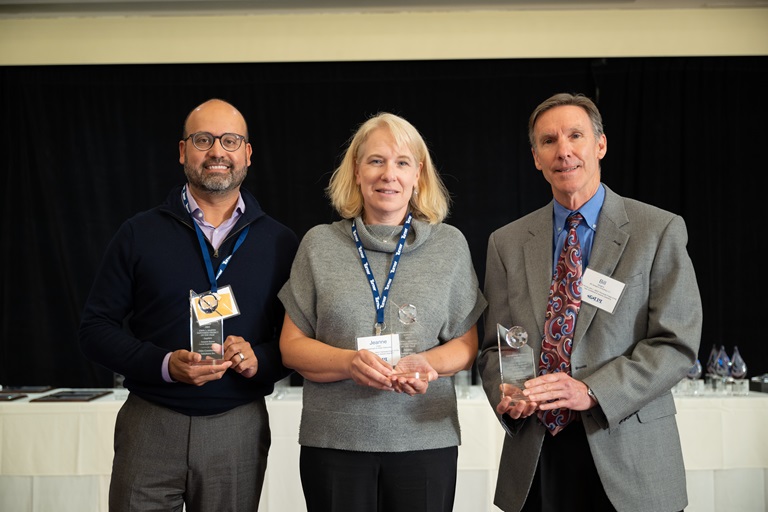DWR Honored for Partnership and Collaboration on Levee Improvement Project
DWR staff members Sergio Fuentes and Jeanne Kuttel with Bill Spragins, consultant, pictured receiving DWR's project of the year award from the International Partnering Institute for their levee restoration work in the San Joaquin Valley.
The Department of Water Resources (DWR) recently received a project of the year award from the International Partnering Institute (IPI) for its successful collaboration and levee improvement work in the San Joaquin Valley. DWR’s engineering team was presented with the award at the IPI Conference and Awards Ceremony held in July in San Francisco.
Launched in 2020, the Eastside Bypass Improvement Levee Project improved the weakest section of the Eastside Bypass, located 15 miles southwest of Merced. Built more than a century ago, the original levee consisted of sand and gravelly soils, which could allow water to pass through, leading to flood hazards.
To fix the vulnerable levee at the Eastside Bypass, DWR constructed about two miles of reinforcement known as a slurry wall. The slurry wall includes denser cementitious material to prevent seepage onto nearby land and a more solid foundation. The engineering team also replaced six aged culverts at the bypass with concrete reinforced pipe. Thanks to successful collaboration with partners, the project was completed early - 300 days ahead of schedule and saving $100,000 in costs. The bulk of the work completed by the fall of 2020.Reducing flood risks and hazards is critical in California, especially as those hazards are amplified by climate change. Recent studies show that a megastorm, fueled by atmospheric rivers, could bring with it severe flooding in the San Joaquin Valley. California is already adapting to a hotter, drier future.
“This team — made up of DWR staff, the contractor, Odin, and the facilitator, Bill Spragins — took partnering to heart and strived to complete work in a single season rather than in two, which greatly benefited the project,” said Jeanne Kuttel, acting manager for DWR’s Division of Engineering.
DWR coordinated the project with the U.S. Fish and Wildlife Service, the Lower San Joaquin Levee District, the Lone Tree Mutual Water Company, and the San Joaquin River Restoration Program. DWR also worked with water districts to ensure no disruptions to water deliveries through the Eastside Bypass. Regular meetings and updates between DWR and its partners played a key role in the project’s success.
“DWR was a great partner to work with,” said Jeff Rankin, project manager with Odin Construction. “Working with an open, direct and fair client on the project was very rewarding and we would gladly work with them again.”
This work also supports the San Joaquin River Restoration Program, a multi-agency effort led by the U.S. Bureau of Reclamation. The San Joaquin River Restoration Program’s goals include restoring river flows, developing a self-sustaining Chinook salmon population, and flood protection through levee improvements.
“Mutual respect, trust and communication within the project team and its partners was key to the successful completion,” said Alexis Phillips-Dowell, supervising engineer and project manager with DWR’s South Central Region Office.
DWR, its partners, and the contractor prioritized construction that did not impact the nearby San Luis National Wildlife Refuge and local wildlife. Bird migration was a particular concern since the area is part of a major migration corridor on the Pacific Flyway.
By adjusting construction start times, the team minimized disruptions to wildlife. Officials at the refuge also granted six extra weeks to allow for project completion in one season rather than two. This innovation resulted in DWR receiving IPI’s Ruby Award for infrastructure projects under $25 million.
“During our initial meetings, DWR and the contractor worked with the refuge to gain trust and to establish a relationship,” said Sergio Fuentes, DWR senior cost estimator. “As someone who champions partnerships, I advise those looking for similar project success to come into the process with an open mind and have a positive attitude.”
For more information on the Eastside Bypass Improvement Program, visit: https://www.restoresjr.net/program-prepares-for-reach-o-levee-work/.
